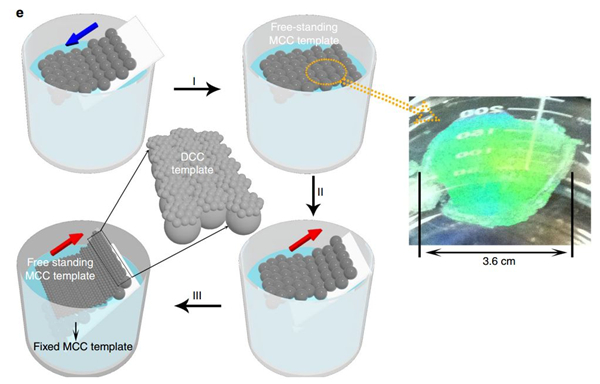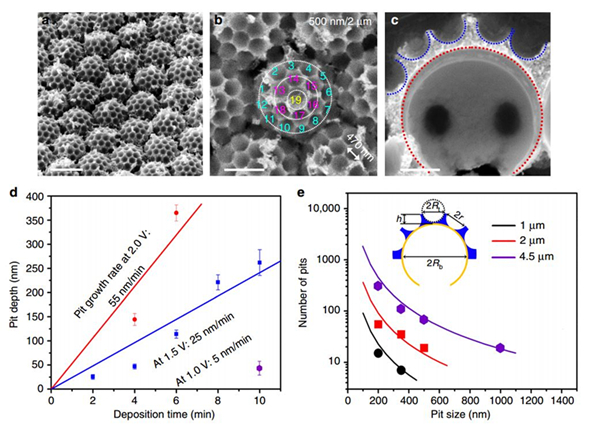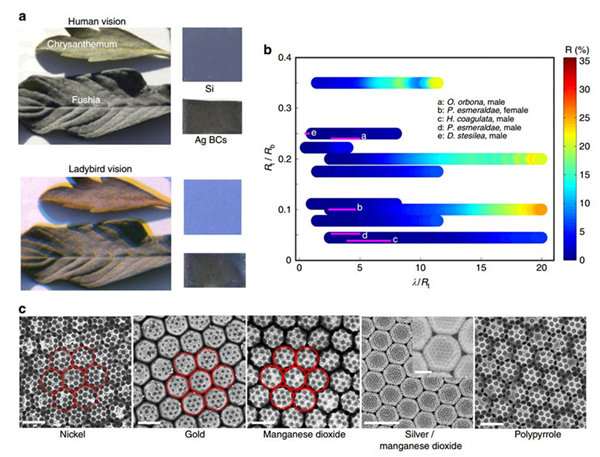Ultra-antireflectivesynthetic brochosomes
Nature Communications (2017, 8,1285)
DOI: 10.1038/s41467-017-01404-8
Thenatural lives have been prompted to gain some unique functions by the naturallaws of natural selection and the screening mechanism of the survival of thefittest in the evolution of millions of years. Theimplementation of such unique features often relies on well-designedmicro-nanostructures. For example, the colorful colors of butterfly wings arederived from micro-nano grooves or pit arrays; the reason why can the lotus livein the silt but not imbrued is due to thousands of ordered micro-nanoprotrusions. Many devices with excellent performance have been designed by studyingthe relationship between structure and function in nature. However, there aremany organisms in nature that have unique functions to be revealed,mitochondria secreted by aphids is one of these important examples.
Themitochondria are hollow micron-sized particles with a closely packed pitstructure on the shell that makes it look like football or fullerenes. Themites continue to smear the secreted mitochondria to the body. Biologists havefound that an important reason for this is that the mitochondrial coating formsa superhydrophobic surface, preventing the mites from being contaminated bysticky excrement secreted by other aphids. Biologists predict thatmitochondria, one of the most complex structures in nature, must have manyother unknown functions, including optics, thermals, courtship, and so on.However, limited to the difficulty in obtaining a large amount of mitochondria,the research on mitochondrial function has become extremely difficult.
Inthe November 3rd issue of Nature Communications (2017, 8,1285), ResearchProfessor Shikuan Yang from Zhejiang University and Professor Tak-Sing Wong ofPennsylvania State University developed a template-assisted, seed layer-inducedelectrochemical deposition method to prepare a large-area artificial granulecoating with a uniform structure. The structure of the mitochondria can beaccurately controlled, which provides numerous samples for the systematic studyof the association between mitochondria structure and its functions. Combinedwith a large number of experimental tests and numerical simulations, theintrinsic correlation between structural parameters of mitochondrial and thereflection of electromagnetic waves is established. It is found that thestructure-optimized mitochondria have excellent anti-reflection properties inthe visible to near-infrared region, and thus have important applicationprospects in the fields of energy, sensing and optoelectronic devices.
Inaddition, it is expected to obtain a mitochondrial coating with excellentanti-reflection properties in the middle and far infrared bands by designingthe microstructure of the mitochondria, which provides a possibility forefficient use of solar energy. The mitochondria preparation method has stronguniversality and is suitable for preparing metals, metal oxides, conductivepolymers, and even multi-component mitochondria, which lays a foundation forthe development of mitochondria in other fields. Finally, studies have revealedthat mitochondria are likely to be used as a camouflage coating to aid in thedetection of mites to escape predators.


Fig. 2 Fabrication of syntheticbrochosomal coating. a Fabrication process of the synthetic BCs. I. Goldevaporation. II. Preparation of DCC template. III. DCC template-basedsite-specific electrochemical deposition which creates BCs after PS spheres removal.b–d SEM images of MCC template (scale bar, 2 µm), DCC template (scale bar, 2µm, and inset, 2 µm), and Ag BCs (scale bar, 2 µm), respectively. e Fabricationprocess of DCC template. I. MCC template transferred onto the air/waterinterface. II. MCC template transferred onto another arbitrary substrate. III.DCC template created by transferring another layer of MCC template onto apre-fabricated MCC template that was thermally anchored on a substrate. Notethat the thermal treatment of the MCC template around the glass transitiontemperature increases the interfacial area, thereby enhancing the bindingbetween the PS spheres and the silicon substrate.

Fig. 3 Structural control of BCs. a, bSEM images of Ag BCs at different magnifications. Scale bars: (a) 2 µm, and (b)1 µm. c Cross-sectional image of a silver brochosome particle. Scale bar: 500nm. d A plot showing the growth rate of pit depth at differentelectrodeposition voltages. Error bars represent standard deviations from 100independent measurements of the pits. e A plot showing the relationship betweenthe number of pits and the pit size on the brochosome particles for a givensize of bottom layer spheres (labeled in inset). Solid lines indicatetheoretical predictions. Inset showing the schematic of the relevantgeometrical parameters of a brochosome-like particle

Fig. 4 Antireflection performance ofthe synthetic BCs. a Optical images of DCC template before and after Agelectrochemical growth, and after the removal of PS beads. Scale bar: 5 mm. b Aplot showing the reflection spectra of Ag mirror (in magenta), Ag honeycombmesoporous film (in blue), Ag nanoporous film (in red) and Ag BCs (in black).Schematic drawings of the corresponding structures are shown on the right. TheAg BCs were prepared by using the DCC template composed of 2 µm large PSspheres with the top surface covered by 500 nm PS spheres. Afterelectrodeposition, the pits of these BCs were 470 nm in opening size and 260 nmin depth. The Ag honeycomb mesoporous film was prepared by electrodepositionusing 500 nm PS spheres on an Au-covered silicon wafer. The depth of the pitswas ~250 nm (Supplementary Fig. 14). c A plot showing the reflection spectra ofBCs with different pit sizes. d A plot showing the angle dependence of the reflectionspectra of the Ag BCs composed of 2 µm particles with pits 470 nm in openingsize and 260 nm in depth

Fig. 5 Possible camouflage function ofBCs and their fabrication in different materials compositions. a Simulatedhuman and ladybird beetle visions of BCs and two different leaf species. bComparison of the structural parameters of natural and synthetic brochosomesfor their optical reflectance; here, the color bar represents the experimentalreflectance measurements of various synthetic BC structures and the magentalines represent the natural brochosomes (i.e., the visible spectrum of theladybird over Rt determines the line length and position along the x-axis).These natural brochosomes include a Oncometopic orbona, male. b Proconiaesmeraldae, female. c Homalodisca coagulata, male. d Proconia esmeraldae, male.e Diestostemma stesilea, male (Supplementary Fig. 24). The observing (incident)angle is 45°. Note that the geometrical parameters of the aforementionednatural brochosomes are located at the low reflection region in the opticalreflectance map obtained from the reflectance measurements of the syntheticbrochosomes. The normalized plot allows one to identify the correspondingantireflection design parameters of the synthetic brochosome given a specificwavelength of light. c Scanning electron micrographs showing various BCsfabricated from nickel (Ni), gold (Au), manganese oxide (MnO2),silver/manganese oxide (Ag/MnO2), and polypyrrole (PPy). Scale bars: 2 µm (Ni,Au, MnO2, PPy) and 5 µm (Ag/MnO2, inset, 2 µm)
In2016, the same team members applied a lubricant-impregnated surface, inspiredby the pitcher, as the ultra-efficient enrichment surface of the molecule to bedetected, and developed the slippery liquid-infused porous surface-enhanced Ramanscattering (SLIPSERS) platform. And it has shown that traces of pollutants,biomolecules, etc. present in any liquid can be subsequently detected throughSLIPSERS (PNAS, 2016, 113, 268-273). At present, the research team of ShikuanYang is further optimizing the SLIPSERS platform to obtain a practical andusable detection system. (Website:http://person.zju.edu.cn/shkyang/698350.html)
Papers:
ShikuanYang*, Nan Sun, Birgitt Boschitsch Stogin, Jing Wang, YuHuang & Tak-SingWong*, Ultra-antireflective synthetic brochosomes, NatureCommunications2017, 8,1285. (https://www.nature.com/articles/s41467-017-01404-8)
ShikuanYang*,Xianming Dai, Birgitt Boschitsch Stogin & Tak-Sing Wong*,Ultrasensitivesurface-enhanced Raman scattering detection in common fluids. PNAS,2016, 113,268-273. (http://www.pnas.org/content/113/2/268.abstract)


